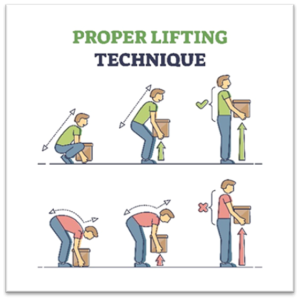Celebrating National Ergonomics Month
Posted on by National Ergonomics Month is celebrated annually in October. While ergonomics broadly is the scientific study of people at work, one important aspect of ergonomics is to prevent injuries and musculoskeletal disorders (MSDs) caused by poor workstation design and work environment. NIOSH ergonomists have been pioneering the study of MSDs through the development of risk assessment tools, the use of emerging technologies and sharing information on effective interventions.
National Ergonomics Month is celebrated annually in October. While ergonomics broadly is the scientific study of people at work, one important aspect of ergonomics is to prevent injuries and musculoskeletal disorders (MSDs) caused by poor workstation design and work environment. NIOSH ergonomists have been pioneering the study of MSDs through the development of risk assessment tools, the use of emerging technologies and sharing information on effective interventions.
MSDs happen when injury occurs to muscles, nerves, tendons, ligaments, joints, cartilage, or spinal discs. Rather than by slips, trips, falls, or other accidents, MSDs are caused by sustained physical exertion.
When these injuries are caused by someone’s work environment or are made worse by a work environment, they can be defined as work-related MSDs (WMSDs). Typically, these injuries result from work tasks such as:
- Lifting or pushing heavy objects or irregularly shaped objects
- Maintaining an awkward posture such as prolonged or repetitive reaching above shoulder height, kneeling, squatting, leaning over a counter or twisting the torso while lifting
- Performing the same or similar tasks repetitively
- Whole body or hand-arm vibration
MSDs continue to be a significant health problem in the workplace. According to the Bureau of Labor Statistics, the rate of WMSD cases was 26.9 per 10,000 full-time workers in 2020. In 2021, total workers’ compensation claims costs included:
- $13.3 billion for overexertion involving outside sources (material handling), ranking first among the leading causes of disabling injuries (Liberty Mutual, 2021)
- $4.7 billion for awkward postures
- $1.7 billion for repetitive motions involving microtasks, small tasks or jobs that are performed in a matter of seconds or a few minutes such as typing
WMSDs are detrimental to both workers’ health and the business economy (Rosado et al., 2022). That’s why investigating workplace related factors for MSDs has been recognized as a critical area of research in the field of occupational health.
The NIOSH Musculoskeletal Health Cross-Sector Program investigates the workplace factors for MSDs by examining data trends, addressing risk factors, developing and evaluating interventions, and disseminating the most effective risk mitigation information. This program aims to promote information exchange, research collaboration and information dissemination among industry representatives, worker unions, and governmental agencies. More information on the program’s mission and accomplishments to date are in the 2022 program performance one-pager and the program website.
The risk for WMSDs is related to the intensity, frequency, and duration of a work task. The first step to preventing WMSDs is to assess risk factors associated with the task. Several risk assessment tools have been developed to evaluate WMSD risks associated with work tasks. The most well-known and widely used tool in the industry is the Revised NIOSH Lifting Equation (RNLE) for assessing manual lifting risks (Barim et al., 2019). NIOSH published a digital version of the RNLE applications manual in September 2021 (see related blog) and a mobile app to help users calculate the lifting index, the outcome risk metric of the RNLE.
In recent years, emerging technologies have been the center of ergonomic research for the prevention of WMSDs such as exoskeletons, wearable sensors, computer vision, artificial intelligence, and virtual and augmented reality. These technologies may enable the automation of ergonomic risk assessments with minimal interference with workers or their work environment. Examples of these technologies in the application of ergonomic risk assessments and interventions include:
- Using computer vision to identify human body posture, motion, and hand activity (see related blog)
- Using inertial measurement units (IMU) to track whole body postures for ergonomic risk assessments (see related blog)
- Exoskeletons in a variety of workplace settings to reduce WMSDS such as:
- Industrial exoskeletons (see related blog)
- Wearable exoskeletons to reduce physical load at work (see related blog)
- Exoskeletons and occupational health and equity (see related blog)
- Implications of artificial intelligence on workplace safety and health (see related blog)
WMSDs are common in all industries, and the risk of WMSDs may become more difficult to assess, as work tasks become more dynamic and variable with job modernization. NIOSH researchers are researching new technologies for automating data collection for using the RNLE for variable tasks. Other NIOSH projects include assessing the longitudinal health effects of exoskeletons on workers’ safety and health, developing technologies for reducing vibration related WMSDs, and using worker compensation data to gain insight into the prevention of MSDs. To find out more about NIOSH projects and accomplishments in WMSD research, please visit our NIOSH Ergonomics Topics page.
Menekse S. Barim, PhD, AEP, is a Research Industrial Engineer in the NIOSH Division of Field Studies and Engineering.
Asha Brogan, MS, is an ORISE Fellow in the NIOSH Division of Field Studies and Engineering.
References
- Rosado, A.S., Baptista, J.S., Guilherme, M.N.H., Guedes, J.C. (2023) Economic Impact of Work-related Musculoskeletal Disorders – A systematic Review, Occupational and Environmental Safety and Health IV. Studies in Systems, Decision and Control, vol 449. Springer, Cham. https://doi.org/10.1007/978-3-031-12547-8_48
- Barim, M.S., Sesek, R.F., Capanoglu, M.F., Drinkaus, P., Schall, M.C., Gallagher, S., Davis, G.A. (2019). Improving the risk assessment capability of the revised NIOSH lifting equation by incorporating personal characteristics, Applied Ergonomics, 74, pp. 67-73.
Posted on by

